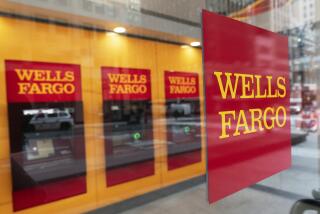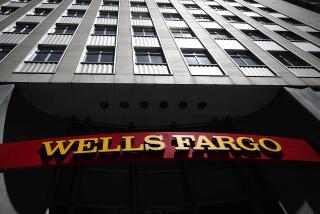Fed caps growth at Wells Fargo over sham accounts, other consumer abuses
- Share via
The Federal Reserve ordered Wells Fargo & Co. on Friday to cap its growth and improve its corporate governance, punishment for what the regulator called “widespread consumer abuses and other compliance breakdowns” at the San Francisco financial giant.
The bank, apparently in response to the action, said it would replace four board members. Fed Chairwoman Janet Yellen said Wells Fargo will not be allowed to grow any larger until it can do so without endangering customers.
“We cannot tolerate pervasive and persistent misconduct at any bank and the consumers harmed by Wells Fargo expect that robust and comprehensive reforms will be put in place to make certain that the abuses do not occur again,” said Yellen, whose term as chairwoman ends Saturday.
The Fed ordered the bank to submit a plan for improving board oversight and risk management. Until the Fed judges that the bank’s practices have improved, the bank cannot increase its total assets beyond $1.95 trillion, where they stood at the end of 2017.
In a statement, Wells Fargo Chief Executive Timothy Sloan said the bank is “focused on addressing all of the Federal Reserve’s concerns.” On a Friday afternoon conference call with investors, he said Fed leaders “believe there is more work that needs to be done, and we agree.”
The Fed’s move is the latest and most serious regulatory action taken against the bank over the last year and a half.
In September 2016, the bank agreed to pay $185 million to regulators for opening accounts for customers without their authorization, a practice first reported by the Los Angeles Times in 2013.
Since then, the bank has also admitted to other improper practices, including charging auto-loan customers for car insurance they did not need and charging improper fees to some mortgage borrowers. Democratic lawmakers, meanwhile, had pressed the Fed to take action against the bank. Sen. Elizabeth Warren (D-Mass.) last summer urged Yellen to remove all of the bank’s board members.
In letters sent to Wells Fargo board members, Michael Gibson, the Fed’s director of supervision and regulation, said those problems show the bank’s board failed to properly oversee the bank.
“The firm’s lack of effective oversight and control of compliance and operational risks contributed in material ways to the substantial harm suffered by [Wells Fargo] customers,” Gibson wrote.
The Fed also sent letters to former Wells Fargo Chairman and CEO John Stumpf and longtime board member and former Chairman Stephen Sanger, saying their performance was “an example of ineffective oversight that is not consistent with the Federal Reserve’s expectations.”
Stumpf, according to the letter, did not take serious measures to address problems with the bank’s sales practices and continued to “support the sales goals that were a major cause of the problem, and the senior executives who were most responsible for the failures.”
Sanger, meanwhile, in his position as lead independent director, failed to press Stumpf and other executives for information “even after you were aware of the seriousness of the problems,” according to the letter.
Sanger, a former CEO of General Mills, had been Wells Fargo’s lead independent director for years before taking over as chairman when Stumpf resigned shortly after the sham accounts scandal first came to light.
He and two other longtime board members, Cynthia H. Milligan and Susan G. Swenson, retired effective Jan. 1.
Wells Fargo said Friday that three additional board members — who were not identified — will retire in the coming months and a fourth will step down by the end of the year.
On Friday’s conference call, Sloan noted that the Fed’s action relates to bad practices already exposed, not to any newly discovered issues.
He also said the cap on assets will not affect the bank’s day-to-day operations but will require some rejiggering of the bank’s balance sheet. Those changes, Sloan said, could result in 2018 profits falling by as much as $400 million. That amounts to less than 2% of the bank’s 2017 net income of $22.2 billion.
Wells Fargo shares were down $3.98, or 6.2%, in after-hours trading to $60.09.
Follow me: @jrkoren
UPDATES:
5:25 p.m.: This article was updated with more details on the Fed’s action, comments from a conference call held by Wells Fargo CEO Timothy Sloan and additional background.
This article was originally published at 4:25 p.m.
More to Read
Inside the business of entertainment
The Wide Shot brings you news, analysis and insights on everything from streaming wars to production — and what it all means for the future.
You may occasionally receive promotional content from the Los Angeles Times.











